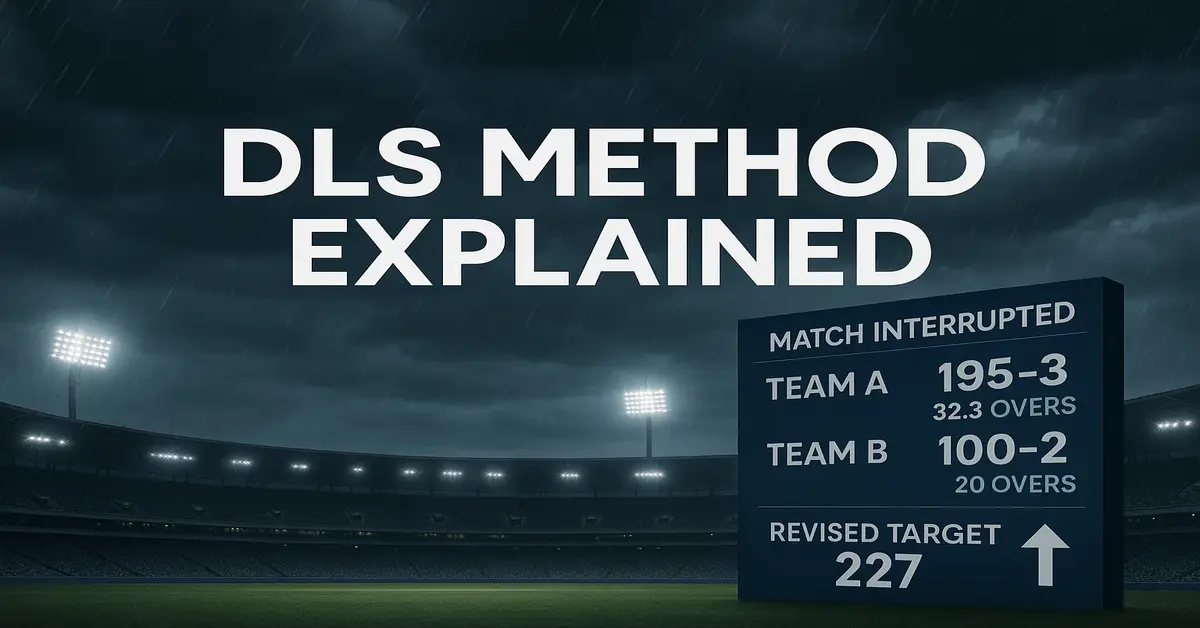How the Duckworth–Lewis–Stern (DLS) Method Works in Cricket – Explained Simply
In a rain-hit match, when the target changes mid-way and fans are left wondering, “How did they come up with this number?”, it’s usually the DLS method at play. Let’s break it down.
What is the DLS Method?
The Duckworth–Lewis–Stern (DLS) method is a mathematical formula used to calculate revised targets in limited-overs cricket matches that are interrupted by rain or other delays. It ensures both teams have a fair chance, even if they don’t get to play the full number of overs.
History: From Duckworth–Lewis to Stern
- 1997: Introduced as the Duckworth–Lewis (DL) method by statisticians Frank Duckworth and Tony Lewis.
- 2014: Updated and renamed as Duckworth–Lewis–Stern (DLS) when Steven Stern became the custodian and made modern-day adjustments.
- Today, it is the official method recognized by the ICC for adjusting targets.
Why is it Needed?
Cricket is unique because every ball can change the game. A match that’s cut short unfairly impacts one side — especially if the chasing team has fewer overs.
DLS solves that problem by:
- Measuring both teams’ available resources: Overs left + Wickets in hand
- Calculating a target that reflects the revised playing conditions
How is DLS target Calculated?
DLS uses a pre-defined resource table to determine how many “scoring resources” a team had or has.
Example:
- Team A played 50 overs with 100% resources
- Team B has 30 overs and 7 wickets left = ~70% resources
If Team A scored 250 with 100%, Team B’s target = (70/100) × 250 = 175
🧮 Our DLS Estimator Calculator simplifies this for fans.
Here, one more point come into picture which is how reduced overs are calculated? if you see the resource table they have overs left from 50- 0 and if rains interrupted, there is loss of time as play gets stopped.
for example, let’s say, match stop for 30 mins and then resume. Now, how is this 30 mins gets cover up. Simply by reducing overs. find more about how is reduced overs get calculated?
Sample Calculation (DLS in Action)
Let’s say:
- Team A scores 300 in 50 overs
- Rain delays Team B’s innings
- They now get only 40 overs and 90% resources
Revised Target = (90 / 100) × 300 = 270 runs
If Team B gets all out for 269, they lose by 1 run.
Use Our DLS Calculator
Don’t want to memorize formulas?
👉 Try our DLS Target Estimator Calculator
Just enter:
- Team A score
- Team A resources used
- Team B resources left
You’ll instantly get the estimated revised target.
Famous Matches Affected by DLS
Here are a few matches that made headlines due to DLS:
- World Cup 1992 Semi-Final (SA vs ENG) – SA needed 22 off 1 ball due to a misapplied earlier version.
- India vs New Zealand (WC 2019 SF) – A rain-delay impacted chase changed the match narrative.
- IPL 2023 – DLS played a crucial role in multiple shortened matches.
DLS vs VJD – Why DLS is Official
In India, there’s another method: VJD (V Jayadevan method), popular in domestic cricket.
But ICC uses DLS because:
- It’s standardized globally
- It handles multiple interruptions
- It’s more robust with modern match data
Frequently Asked Questions (FAQs)
Q: What is DLS full form in cricket?
A: Duckworth–Lewis–Stern
Q: Can DLS ever favor one team unfairly?
A: Rarely. But in low-scoring or T20 games, it can feel harsh. ICC frequently reviews it for balance.
Q: Does DLS consider individual performance or momentum?
A: No. It’s purely mathematical — only overs and wickets matter.
Q: Can teams prepare for DLS situations?
A: Yes! Teams often accelerate if rain is expected, knowing how DLS might increase or decrease targets.
Final Thoughts
The DLS method keeps the game fair during rain-affected matches, but it’s often misunderstood by fans. Now that you know how it works, you’re ahead of 95% of viewers!
+ More Cricket Calculators – Check out these tools to enhance your match understanding:
- Net Run Rate Calculator
- Strike Rate Calculator
- Required Run Rate Calculator and more at Calculators section.
Stay ahead of the game. Stay with CrickInsights 🏏

